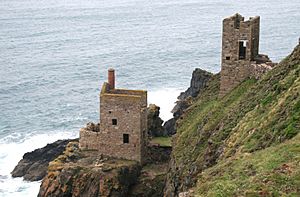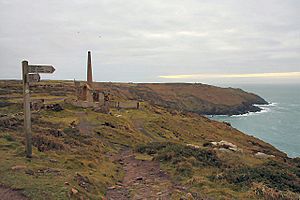Botallack Mine facts for kids
Quick facts for kids Botallack Mine |
|
|---|---|

Engine houses at Crown Mines
|
|
| Type | industrial heritage, mine |
| Owner | National Trust |
| Type | Cultural |
| Criteria | ii, iii, iv |
| Designated | 2006 (30th session) |
| Part of | Cornwall and West Devon Mining Landscape |
| Reference no. | 1215 |
| United Kingdom | List of World Heritage Sites in Western Europe |
|
Listed Building – Grade II
|
|
| Lua error in Module:Location_map at line 420: attempt to index field 'wikibase' (a nil value). | |
The Botallack Mine (Cornish: Bostalek) is an old mine located in Botallack, Cornwall, England. It's a special place because it's part of a World Heritage Site recognized by UNESCO since 2006. This area, called the Cornwall and West Devon Mining Landscape, shows how important mining was here. The mine is also near the beautiful South West Coast Path, which runs along the cliffs. It's also part of a special nature area known as the Aire Point to Carrick Du Site of Special Scientific Interest.
Contents
Where is Botallack Mine?
Botallack village is found on the B3306 road. It's in an area that was once very busy with tin and copper mining. You can find it between the towns of St Just in Penwith and Pendeen.
The History of Botallack Mine
Botallack was a very unique mine because its tunnels went far out under the sea. Some tunnels stretched for half a mile! Over its working life, the mine produced huge amounts of valuable minerals. Miners dug up about 14,500 tonnes of tin, 20,000 tonnes of copper, and 1,500 tonnes of arsenic. They also removed about 1.5 million tonnes of waste rock.
Early Mining Days
It's not clear exactly when mining started here. Records show activity from the 1500s. Some clues even suggest people were mining here much earlier. This could have been during the Roman era or even as far back as the Bronze Age.
In the early 1700s, a mine captain named Henry Boynes dug a "deep adit level." This was a special tunnel for drainage. The first steam engine used for mining in this area started working around 1795 or 1810.
A Royal Visit and Changing Times
In the first half of the 1800s, tin from Botallack was quite valuable. A tax on tin, paid to the Duke of Cornwall, was removed in 1838. This helped the mine keep going even when tin prices dropped.
A new diagonal shaft was dug in the 1860s. In 1865, something exciting happened: the Prince and Princess of Wales visited the mine! They even went down the shaft. This royal visit made the mine famous and brought in tourists. The mine even charged visitors a guinea (an old British coin) to look around.
Why the Mine Closed
In the late 1800s, more tin started coming from other countries like Malaysia and Australia. This caused the price of tin to fall a lot. Many Cornish mines struggled and had to close.
In 1883, the managers of Botallack Mine decided to stop the engines. There weren't enough miners working underground to cover the costs. The mine, including its various sections like Wheal Cock and the Crowns, was put up for auction. It had many important machines, like pumping and winding engines. However, nobody bought the mine.
What Was Inside the Mine?
Even though it was struggling, the mine was still a huge operation. In 1884, many shafts were working. These were deep tunnels that went down into the earth and under the sea. For example, the Botallack engine-shaft was about 400 metres deep. The Boscawen diagonal-shaft was about 900 metres long and went 550 metres under the sea!
The mine also had many powerful engines. These included engines for pumping water out, winding miners and ore up, and crushing the rock (called stamping).
About 265 people worked at the mine in 1884. Their total monthly wages were around £800.
| Men | Boys | Girls | Total | |
|---|---|---|---|---|
| Underground | 140 | 20 | 0 | 160 |
| Surface, dressing ore | 18 | 20 | 17 | 55 |
| Surface, other | 45 | 2 | 3 | 50 |
Each month, the mine typically produced about 19 tonnes of tin, 3 tonnes of copper, and 4 tonnes of arsenic.
Finally, the Botallack Mine closed in 1895. This was because the prices of tin and copper kept falling too low.
What Botallack Mine Looks Like Today
The most famous parts of Botallack Mine are the engine houses at the Crowns section. These buildings are dramatically placed low down on the cliffs, north of Botallack. There are two main engine houses still standing, and the remains of two more higher up. The mine tunnels still stretch about 400 metres out under the Atlantic Ocean. The deepest part of the mine is about 500 metres below sea level.
The mine's tunnels also went inland, reaching as far as the road from St Just to St Ives. The National Trust now looks after the mine buildings on Botallack Cliffs. You can also see the remains of two arsenic works near the mine. These were places where arsenic was processed.
A special mineral called Botallackite was first discovered here. That's why it has the mine's name!
Botallack in Pop Culture
Botallack Mine has been used as a filming location for popular TV shows. The 1970s BBC series Poldark filmed some scenes here, using Manor Farm as the fictional Nampara. More recently, the newer Poldark series also filmed at Botallack.



